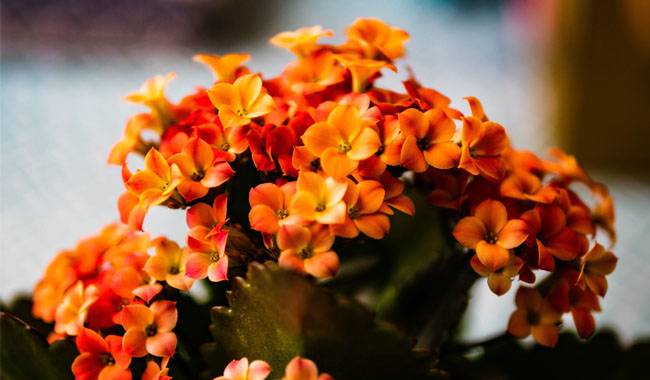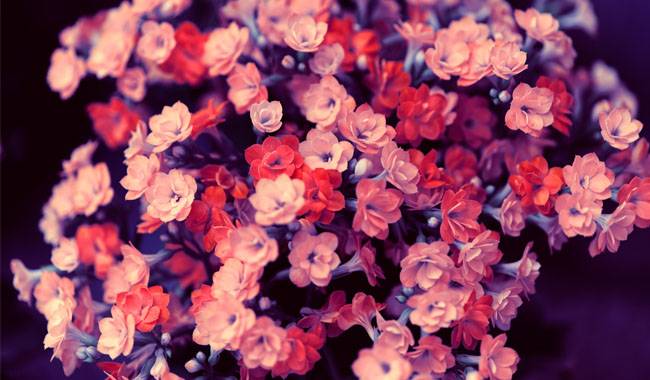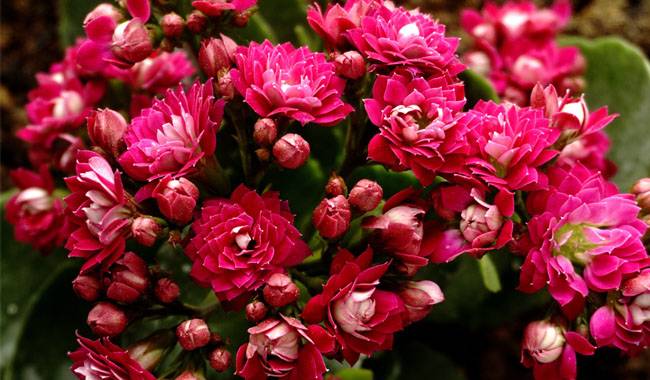
Of all the beautifully flowering hybrids and Kalanchoe varieties, one plant has become not only popular but almost a reference plant. Kalanchoe is a special variety of a familiar plant whose appearance balances bright flowers with the freshness of dark foliage. Kalanchoe combines beauty with simplicity and is often found as a gift or seasonal decoration in the home. But it is a proven indoor perennial that can be enjoyed for years to come with minimal effort. If you can arrange for proper overwintering, Kalanchoe can become an annual show that stretches for months. You will learn how to grow Kalanchoe plants in ThumbGarden’s article.
KALANCHOE PLANT DESCRIPTION
Among the many hybrids of the beautifully flowering, wind-resistant, easy-to-grow Kalanchoe Blossfeld, there are a number of plants that are easily recognizable in appearance and character. Among the Kalanchoe plants that flower, Kalanchoe is one such standout. Gorgeous, swollen flowers and extremely long blooms are not the only hallmarks of Kalanchoe that make it the most popular type sold before the winter holidays.
Kalanchoe” is a group of Dutch Blossfelde varieties that have become a trading name in their own right, an easily recognizable brand name. Having only appeared on the houseplant market in 2003, Kalanchoe has managed to become the most popular tumbleweed hybrid of all Kalanchoe.
Kalanchoe may be small, medium, or large, ranging from 4-13 inches (10-35 cm). But it is always easy to identify by its sturdy, straight shoots. The oval leaves, up to 2 inches (5 cm) long, sit opposite and show a somewhat understated olive color with faintly pronounced coarse serrations on the edges, looking upward.
Kalanchoe flowers in winter and early spring, when there is a serious lack of bright color indoors. The large, flat, double flowers, up to 0.4 inches (1 cm) in diameter, look dazzling. The flowering branches rise above the foliage and merge into a solid cushion, creating a layered, massive effect.
“What started as a bright pink hybrid, Kalanchoe now offers a wide range of shades. Whether orange, white, yellow, or red, Kalanchoe always maintains its brightness. There is also a pleasant contrast between the green Kalanchoe buds and the dazzling flowers. Their color is variable, and it is surprising how different shades of the same shrub may be in a new location.
The main pride of all our Kalanchoe is their “guaranteed” bloom time of at least 6 weeks. However, with good light and excellent care, they can bloom for up to 6 months.
GROWING CONDITIONS FOR KALANCHOE

As long as there is plenty of light and it is not excessively cool, this should not be a problem. However, without a cool overwintering period, flowering is almost impossible to achieve.
Light and positioning
Kalanchoe, despite appearing to be “living bouquets,” is unlikely to be displayed indoors. These species require the brightest possible light to bloom, preferably in a sunny location fully. East and west-facing bay windows are fine, but south and partially south-facing windows need protection from direct sunlight. Even slight shading can cause plants to buckle and stretch. If the weather is too overcast, additional light is often necessary to bloom.
But don’t confuse light intensity with the need for longer days: Kalanchoe is a winter-blooming variety that requires 14 to 16 hours of darkness. You can use artificial shade to regulate the amount of daylight for flower bud formation.
Temperature and ventilation
During flowering, winter, and early spring, Kalanchoe prefers excellent indoor conditions – temperatures of 60-64 °F (16-18 °C). During active growth, Kalanchoe grows well at any temperature between 68 °F (20 °C). To stimulate flowering, move plants to cooler temperatures of about 57-59 °F (14-15 °C) – up to 60 °F (16 °C) – 1.5 months before the expected “start” for laying flower buds, combining coolness with limited watering and controlled light days.
Kalanchoe fears cold drafts and sudden supercooling and should protect plants during the cold season. However, without adequate access to fresh air, shrubs will quickly become infested with pests and wilt. In summer, Kalanchoe can be taken to the garden and kept at night temperatures – it should not be lower than 57 °F (14 °C).
CARING FOR KALANCHOE AT HOME

Even very busy flower growers will do very well with Kalandives. They are watered very infrequently, so the care of the plant is quite compatible with travel. The main thing is to avoid overwatering and to be careful with everything.
Watering and air humidity
Kalanchoe needs to be watered very carefully and is even more sensitive to over-watering than other Blossfeldt varieties. The substrate must be allowed to dry out between waterings so that there is no risk of overwatering, and the water must be removed from the shelf immediately. These varieties can tolerate short periods of complete dryness without affecting flowering. The need for watering is often indicated by loose foliage. Watering once a week, even in high summer, is sufficient for Kalanchoe.
An almost dry dormant period is arranged to stimulate flowering, limiting it to a minimum of support. The shrub should be watered about half as often in winter as in summer during the flowering period.
When watering, ensure that the water quality is correct and that the greenery and shoots are not soaked.
There is no need to increase air humidity, but Kalanchoe welcomes sprinkling in the hot summer months. Dust should be wiped off the leaves regularly.
Fertilization and composition of fertilizer
To make the luxurious flowering of Kalanchoe last for many months, you need to choose the right fertilizer. In addition to the main macroelements, only fertilizers for succulents that contain trace elements (magnesium, potassium, manganese, iron – their lack is very dangerous) can produce good results for this plant. Fertilizers for beautiful flowering plants should be applied to bushes, reducing the dosage by two to three times.
During the active vegetation period, fertilizers should be applied every 2-3 weeks. During the dormant period, discourage them.
Pruning and trimming Kalandiva
Basic pruning is done at the end of flowering. Shoots are shortened to short stakes. The shoots need to be pruned during the growing season to keep them compact and bloom more abundantly.
Transplanting, container, and substrate
A light, nutritious, loose, and the relatively coarse-textured substrate is needed. Unique substrates for succulents or pretty flowering plants should be used. The necessary ingredients are deciduous soil, sand, and perlite.
Kalanchoe grows better in ceramic containers. Choose compact pots even for larger varieties, as too much space is impossible to achieve abundant flowering.
If you buy Kalanchoe as a seasonal plant and intend to discard it, there is no point in transplanting the plant: Place the bush in a nice pot or container with the old container for maximum decorative effect. When planting perennial Kalanchoe, keep it after flowering and transplant it after flowering and pruning, laying down a high drainage layer each year and transplanting the bush into a slightly larger container.
Diseases, pests and growth problems
Kalanchoe is very susceptible to decay. The stems and roots will rot quickly, even with slightly more watering. And since plants can usually only be saved by re-rooting and sprouting, special attention should be paid to watering quality. Occasionally, under unfavorable conditions and in unventilated rooms, an aphid infestation can be treated with any insecticide.
Propagation of Kalanchoe
Kalanchoe can be grown by trying to grow it from seeds or cuttings. Asexual propagation is the quickest and most reliable method. Cut off the shoots in spring and summer. The best propagation method is to use cuttings of up to 6 inches (15 cm) in length.
After removing the lower leaves and cutting them dry, plant the cuttings in a light, succulent substrate and keep them lightly moistened.







